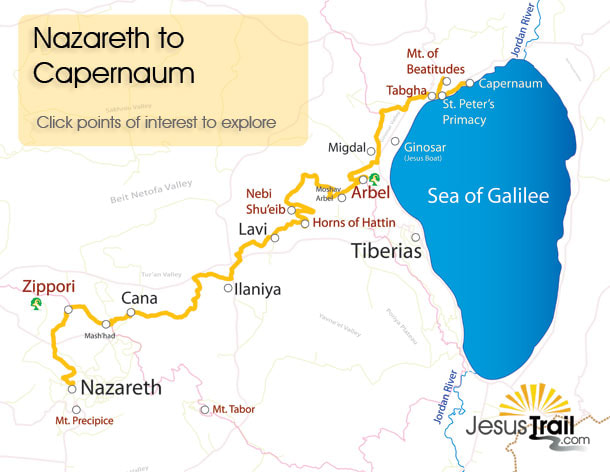|
The Gospel of John mentions a town named Cana. John specifically tells us Cana is in Galilee, which is a region in Northern Israel. The location of the biblical town is widely debated today, however, the name Cana may derive from the Hebrew word for “reeds”, which suggests the town was located near marsh or grasslands.
In the Bible, Cana is best known as the place where Jesus performed his first public miracle. Told in chapter two of the Gospel of John, “a wedding took place at Cana in Galilee.” (John 2:1) “What Jesus did here in Cana of Galilee was the first of the signs through which he revealed his glory; and his disciples believed in him.” (John 2:11) Jesus was attending a wedding in Cana with his mother and disciples. During the celebration, the host ran out of wine and Mary asked her son to do something about the situation. Jesus instructed the servants to fill six stone jars with water, however, when the master of the banquet tasted the liquid, it had become wine. Although this is believed to be Jesus’ first miracle, it is not recorded in the synoptic Gospels. The Gospel of John mentioned Cana a further two times. “Once more he visited Cana in Galilee, where he had turned the water into wine. And there was a certain royal official whose son lay sick at Capernaum.” (John 4:46) When the man heard Jesus was in Cana, he begged Jesus to heal his son. Jesus declined to go with the man to his house; however, Jesus promised his son would live. As Jesus was saying this, the fever left the young boy, and Cana became the location of a second miracle. The final time Cana is mentioned in the Gospel of John is in relation to one of Jesus’ disciples. “Afterward Jesus appeared again to his disciples, by the Sea of Galilee. It happened this way: Simon Peter, Thomas (also known as Didymus), Nathanael from Cana in Galilee, the sons of Zebedee, and two other disciples were together.” (John 21:1-2) Nathanael from Cana is more commonly known as Bartholomew the Apostle who was born in Cana during the 1stcentury AD. He was first mentioned in John 1 when Philip introduced him to Jesus. When Jesus met Nathanael, he said, “Here truly is an Israelite in whom there is no deceit.” (John 1:47) Jesus promised Nathanael that he would “see heaven open, and the angels of God ascending and descending on the Son of Man.” (John 1:51) St Bartholomew (Nathanael) was later skinned alive and beheaded in Albanopolis, Armenia, where he is now celebrated as the patron saint of the Armenian Apostolic Church. In some versions of the Bible, Simon the Zealot, as he is known in the NIV, is known as Simon from Cana or Simon the Cananite. (Matthew 10:4, Mark 3:18) Simon was another of Jesus’ apostles who, like Nathanael, may have been born in Cana. Some scholars, however, contest his place of birth, pointing out the Hebrew for “zealous” and “Cana” both derive from the same word, qanai, therefore, “Simeon from Cana” could be a mistranslation. The location of Cana has baffled historians for centuries and many theories have been developed. There have been some suggestions that Cana may not have been a real place, however, the name of the town has also featured in The Life of Josephus written between 94-99 AD. To date, five places have been proposed as the true location of the town. They are Qana, Lebanon; Kafr Kanna, Israel; Khirbet Qana, Israel; Karm er-Rasm, Israel; and Ain Qana, South Lebanon. The early Christian historian, Eusebius of Caesarea, selected Qana in Lebanon as the location of Cana during the 4thcentury. It is a village situated approximately 18 miles from the city of Tyre. It is said that Jesus’ first miracle took place in one of the natural caves in the village, which contain ancient inscriptions on the rock. In the 17thcentury, a papal emissary to Palestine reported two possible locations of Cana: Khirbet Qana and Kafr Kanna. The latter, located 4.3 miles from Nazareth, was considered to be the location of Cana long before the emissary’s visit, however, there is no tangible evidence for this. Although Arabs predominantly inhabit the town, there are a few Catholic churches, including the Roman Catholic Chapel of the Apostle Bartholomew and the Franciscan Wedding Church. Khirbet Qana, on the other hand, means “ruins of Cana”, giving it more standing as the true location of the city. The village is 8 miles from Nazareth and contains the remains of a settlement from the Early Arab Period. Maps produced by the Crusaders cite Khirbet Qana as the biblical Cana, however, since the village lies in ruins, there is little other evidence. Meanwhile, Yardenna Alexandre, an Israeli archaeologist, is convinced the ruined site of Karm er-Rasm is the true location of Cana. Excavations have revealed it was once inhabited by a Jewish population and eventually abandoned in the Byzantine period. Unfortunately, no one else agrees with her theory. Finally, Ain Qana, which means “the spring of Cana”, is an agricultural town that has been considered as a better candidate for the biblical Cana. Situated only a mile from Nazareth, early Christian pilgrims reported the town contained a spring from which the jars at the wedding may have been filled. The spring is no longer there and excavations have not yet taken place. Once again, there is not enough evidence to determine if this is the true location. For now, Cana remains missing!
1 Comment
Jocelyn
12/31/2021 03:08:33 pm
How far between Capernaum and Cana? How long would it have taken the Roman official to walk there? John 4: 46-:53?
Reply
Your comment will be posted after it is approved.
Leave a Reply. |
©Copyright
We are happy for you to use any material found here, however, please acknowledge the source: www.gantshillurc.co.uk AuthorRev'd Martin Wheadon Archives
June 2024
Categories
All
|

 RSS Feed
RSS Feed